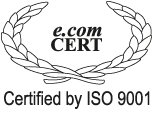Solaris Urbino Electric
Please enable Javascript and Flash to view this Flash video.
Zero Emission: Solaris Urbino electric
The new Solaris Urbino electric brings autonomous electric mobility to our cities. Solaris’s first electric bus covers up to 100 km without any need to be recharged. A host of new design features brings down the vehicle’s weight and compensates for the burden of the batteries. Volume production will start in 2013.
“Diesel is dead – long live electricity!” Solaris founder Krzysztof Olszewski’s words, spoken at the unveiling of the first Solaris hybrid bus five years ago, today are truer than ever as the new Solaris Urbino electric bus takes centre stage. Zero emission, quiet operation and independence from rising fossil fuel prices are just three of the Solaris Urbino electric’s key attributes for sustainable mobility.
Flexible Operation
Offering up to100 kmrange when measured against the UITP-defined SORT 1 and SORT 2 cycles and charging its batteries in just four hours, the new Solaris Urbino electric enables flexible operation.
The bus has been based on the proven Alpino 8.9 LE midibus. The new electric drive takes up less space, allowing the rear axle to be moved by310 mmtowards the back of the bus, freeing up valuable space for passengers on board. With its skilful use of the low-entry concept, the Solaris Urbino electric offers plenty of seats despite its small dimensions. At just8.9 mlong and2.4 mwide, the bus shown at Busworld Kortrijk nevertheless has 26 seats. Depending on specification, between 21 and 29 fixed seats and an additional two tip-up seats are possible. Step-free entrances make the bus easily accessible, with a dedicated space for wheelchair users and pushchairs reserved opposite the second door.
Sophisticated Electric Drive
The drivetrain of the Solaris Urbino electric is supplied by Solaris’s system partner Vossloh Kiepe. The German specialist has built on decades of experience as a manufacturer of electric traction equipment to bring the perfect set of technology to the Solaris Urbino electric. At the heart of the bus is a 120 kW, four-pole asynchronous electric motor, delivering up to 1.400 Nm torque. It has been fitted underfloor at the back of the bus, where it powers the rear axle and smoothly brings the electric bus up to usual city traffic speeds of 50 km/h.
Energy is stored in two 700 kg lithium-ion batteries with a combined capacity of 120.9 kWh at a nominal voltage of 600 V. The batteries are supplied by Wamtechnik of Warsaw and are mounted at the rear of the bus on each side of the motor. During braking, energy is recuperated and stored in the batteries, which additionally are charged from an external plug-in connection. At 3×400 V, 63 A, it takes as little as four hours to completely refill fully exhausted batteries.
With the batteries tucked away within the engine compartment, only the system’s power electronics and the legally required brake resistor are mounted on the roof. The brake resistor would only be used if the batteries could not offer any capacity for recuperated energy, a situation that is avoided at virtually all times by the Solaris Urbino electric’s energy management software.
Light Construction Reduces Weight
Current energy storage technology requires heavy batteries. To compensate for this additional burden as far as possible, the Solaris Urbino electric consistently uses new approaches to lightweight construction.
The use of new, lighter materials leads to reductions in weight. Engine flap and side panelling of the prototype are made from carbon fibre, while the interior roof panels use foamed aluminium composite material. Mahogany instead of birch plywood was chosen for the floor, aluminium rims replace steel, and classic seat mountings and thinner side windows shed further pounds.
Bringing down the weight further is the electric drive itself. It makes fuel tanks, fuel itself and lubricants superfluous and reduces the weight total by another 350 kg. All this means that the Solaris Urbino electric weighs in at just 750 kg more than its conventional, diesel-powered siblings.
All Auxiliaries Electrified
To enable a fully electric set-up, all auxiliaries have been electrified. This also includes air-conditioning units, which are available optionally. All exterior and interior lighting has been changed to energy-efficient LED technology.
Drivers of the Solaris Urbino electric will enjoy the ergonomic touch-screen dashboard, which clearly lays out all vehicle functions along with constantly updated energy management data, including battery charge levels.
Volume Production Starts in 2013
The development of the Solaris Urbino electric was supported by a 30 per cent financial contribution of the European Regional Development Fund.
Presented at Busworld is a prototype, which will soon begin a demonstration tour of major European cities, where it will run in commercial passenger service. Further vehicles follow in 2012, with volume production to start in 2013, making the Solaris Urbino electric a common sight in zero-emission public transport across Europe.
Solaris CEO Solange Olszewska comments: “This electric bus is a revolution in public transport and a significant step towards new operational possibilities for electric vehicles. Not very long ago, such vehicles seemed to be visions of a far-distant future, but in the Solaris Urbino electric we now present a fully electric bus that will reduce noise and pollution in our cities.”
Technical Specifications
Solaris Urbino electric – Exhibition Vehicle
| Dimensions | |
| Length | 8 950 mm |
| Width | 2 400 mm |
| Height | 3 250 mm |
| Wheelbase | 4 380 mm |
| Front overhang | 2 080 mm |
| Rear overhang | 2 490 mm |
| Angle of approach | 8° |
| Angle of departure | 9° |
| Maximum entrance step height | 320 mm |
| Axles | |
| Number of axles | 2 |
| Front axle | ZF RL 55 EC (independent suspension) |
| Drive axle | DANA G150 |
| Body | |
| Bodyframe | Stainless steel |
| External sheeting | Stainless steel and carbon fibre |
| Door layout | 1-2 |
| Number of seats | 26 |
| Drivetrain | |
| Electric motor | Four-pole asynchronous motor (120 kW, 1 400 Nm) |
| Traction batteries | Lithium-Ion (120.9 kWh, nominal voltage 600 V, weight 2×700 kg) |



























